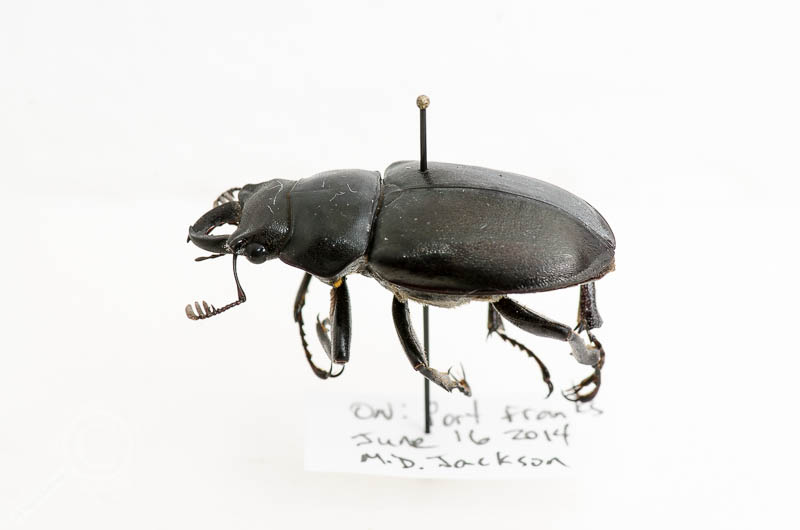Even though all specimens in a natural history collection (should) have a label explaining where, when & how they were captured, sometimes that doesn’t include the full story behind how a specimen came to rest in the collection. Consider the following.
While enjoying a few cold beverages on a hot summer’s evening on the porch of a friend’s cottage, our conversation was interrupted by the *thud* of a beetle bouncing off the siding. Attracted to the lights of the cottage, a Lucanus stag beetle found itself suddenly the highlight of the evening, and I quickly scooped it up and placed it into an inflated Ziploc bag, intending to photograph it once I got home the next day.
Things got busy though, and I ended up stashing the baggy & live beetle in my backpack to take into the lab and photograph instead. The next morning I walked to work, told my lab mate about my great beetle find, and pulled the Ziploc bag out to proudly display my specimen. Rather than a glorious reveal however, and all I had in hand was an empty Ziploc; apparently the beetle had had enough of waiting around and had chewed its way to freedom!
I proceeded to empty my backpack, searching every crack & crevice in search of the missing stag, only to conclude it had not only escaped its plastic cell, but also my zippered backpack as well! As I sat and wondered where it may have made its dramatic escape (perhaps the greeting card store in the mall I had stopped at on my way in to work, a scenario that I couldn’t help but giggle over) and cursed my beer-induced logic that a Ziploc bag was sufficient to imprison a two-inch beetle with formidable jaws, I resigned myself to the fact that I had been outsmarted by the Houdini of the beetle world.
A few nights later, while sitting on the couch at home watching late-night TV, I heard what sounded like plastic shooting across the laminate floor, emanating from where where our cat, Callie, was playing across the room. When I got up to see what trouble she was getting into, low and behold there was my missing stag, skittering across the floor after a playful thwack from the cat! While certainly dead, considerably dried up, and covered in an embarrassingly thick coating of dust from spending time under the furniture, it was also miraculously complete, not even missing its lamellate antennae or fragile tarsi.
A week soaking in ethanol on my desk (out of reach of the cat, who was unimpressed with me confiscating her new toy) to rehydrate, and voila, a perfectly good specimen ready to become a part of the scientific record! It’s impossible to predict how this specimen may contribute to our understanding of biodiversity and stag beetle biology in the future, and while its official label data will provide future researchers the necessary context to use this specimen as a data point, the full story of how this beetle wound up in our collection is yours.
It just goes to show that there’s more to a specimen than meets the eye, or the label.



